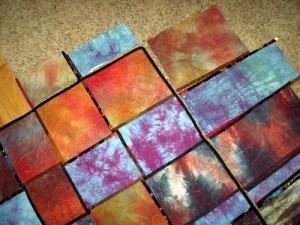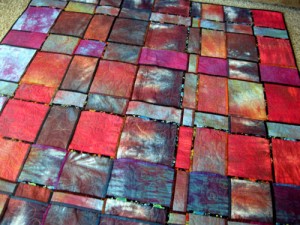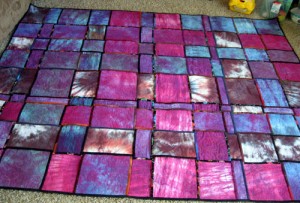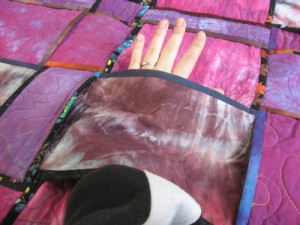By: Kim Lapacek
I am going to try to break down for everyone the steps I took in making my woven wonder quilt. Unfortunately, I did not take pictures during the process and I have no near plans to recreate this amazing quilt. This has also been an ongoing project for the past four years so my memory is a bit hazy at parts. The best thing to remember is that you can adjust lengths and amounts to fit the size quilt you want to do…just takes a little extra math!

The Story BEHIND the MAGIC
I HATE matching my corners when piecing a quilt. I absolutely HATE it. So, one day I had this brilliant idea (or so I thought at the time)…I would WEAVE a quilt…that way, I didn’t have to worry about my corners matching. I should add here that I had this brilliant idea in the beginning of 2005.
Instructions
STEP 1: Decide that weaving a quilt is somehow easier to do than taking a little extra time to match your corners.
STEP 2: Either hand-dye ten 8′ long strips of fabric or choose ten 8′ long lengths of commercial fabric for your woven quilt. I sent five sets of panels (ten strips total) to my long arm quilter to quilt. If I would have had the machine I have now (Janome 6600) I would have done this myself.
STEP 3: Cut long, thinner strips out of your 8′ long panels. I chose to vary the widths’ of each strip just to add another dimension to the final product. To do this, I set up on my hard wood floor with my rotary cuter and cutting mat. It is EXTREMELY important to cut straight edges! If you don’t the quilt won’t fit together very well. I slid my mat along on the floor to cut and left my pieces out at 8′ lengths instead of dealing with folding. It worked pretty well, just not the best on your knees!
STEP 4: Bind two of the long edges of the majority of your strips. Decide the four strips that are going to make up the outer edge and only bind one long side of those.
STEP 5: Weave the quilt together. This is using the simple over under technique to weave. I laid out all in one direction first and then wove the remaining strips in the other direction.
STEP 6: Square it up! This was one of the most difficult steps in my process. My husband helped me with this. We would measure in multiple locations each direction, tweak it a bit, and measure again. To ensure that it was square we measured opposite corner to opposite corner in each direction. These need to be equal and then you know it is square.
STEP 7: Once I had it laid out how I wanted it, I roughly stitched each intersecting corner with quilting thread. Quilting thread is stronger than regular thread so it withheld the weight of the quilt better when being moved around. (Remember…this is basically two quilts).
STEP 8: Trim the excess parts of the strips. I then saved these excess parts and am making clutches and bags with them!
STEP 9: Bind the outer edge. Do this the same way you would normally bind a quilt. Don’t kid yourself…this is not easy. You have to keep the quilt as square as possible and it is HEAVY!
STEP 10: Send quilt back to the long arm machine and have them quilt squares around each intersection. I tried to skip this step but the quilt would not keep its shape. I would have to relay it out every time I moved it.
STEP 11: Enter the quilt in a show! This must be on display if you have the energy to try making one!
STEP 12: Once you’re done showing your quilt off, snuggle up in it and keep warm!
STEP 13: Work on matching your corners. It’s much simpler than weaving a quilt!
I hope you enjoyed my "Tutorial"!
Kim Lapacek




I just couldn’t resist commenting on your ‘hatred’ of matching corners. I found a fabulously easy way to eliminate a great deal of corner matching.
try this: take two 9 1/2 inch blocks, in coordinating colors. put the lighter one on top. put piece of masking tape on your sewing machine exactly 3 1/4 inches from the needle, to create a sewing guide. sew down one side then the other. turn the block one turn then sew down one side then the other. Nine patch pattern created. now using little sharp scissors clip the center TOP piece out, leaving the bottom intact, then do the same for each corner. one perfectly ‘corner matched’ nine patch block done. the blocks and picket fence on the pony quilt on my blog were done that way.
I think you made a fabulous quilt!
I’m having a flash-back! I remember wanting to do something similar for a boy I liked way back in highschool! (ca. 1980!)
I didn’t contemplate it for the reason of not matching corners, I just wanted to make quilted strips and them weave them into a quilt because I thought that would be interesting. I wasn’t going to bind them, I was just going to make tubes including the batting and turn them RSO.
I remember wondering if the weave would open up when the bed was being used, leaving big gaps, or if the fact that it’s basically 2 layers of quilt would make up for that.
I think you did a brilliant job! You should send it in to the magazines, they love new ideas. It’s a beautiful quilt.
Thank you for sharing!
Hey Kim – Just a thought here if you want to attempt this again. What if you tore your long strips, quilted them together and sewed about 1/4 inch from the edge then just left them rag. They could even be washed before you wove them. The frayed edges would help with the extra weight, lots less work than binding and might help “lock” your layers together.
A little food for thought!
Barb
I saw this quilt at a quilt show. It was hung so you could see both sides. It is breath-taking. It is interesting to learn how it was made, and the problems encountered. Glad I was able to see it in person.
I’ve never seen one of these before, it’s wonderful. Looks very hard thou, but your step by step solved some of the mystery.
I love this and can appreciate how much work into it. I hate doing any kind of binding and yours was full of it! But it looks gorgeous.